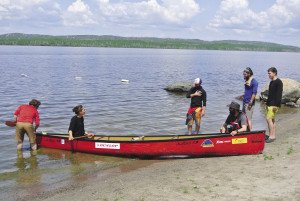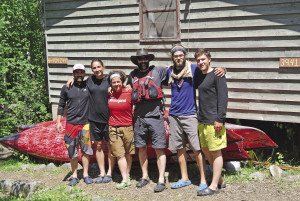GUNFLINT TRAIL—Martin Trahan lost 25 lbs. in just over two months while paddling, portaging and trudging from Montreal to Gunflint Lake. That’s probably why the cheeseburger he devoured at Trail Center Restaurant along the Gunflint Trail tasted outrageously delicious.
“I actually had two,” Trahan admitted, though the burgers were not both consumed in one sitting.

Trahan is among a group of six Canadian adventurers traveling some 7,000 miles from Lake of Two Mountains near Montreal, to their final destination along the Mackenzie River near the Arctic Ocean. The expedition set forth on April 25, traveling in a trio of 18-foot tandem Souris River Kevlar canoes. The adventure is set to conclude on Oct. 20.
Traveling under the name “On the Blue Gold Paths,” (officially “les chemins de l’or bleu” in French), the group stopped at the 1/3-mark of their journey to rest, resupply and enjoy a break in the United States. This happened to be on the shores of Gunflint Lake, where the group stayed in a bunkroom at Gunflint Lodge for five nights at the end of June. It was the first time in Minnesota for all of the adventurers, and apparently the Land of 10,000 Lakes was a welcome resting point.
“It’s beautiful here,” said Annik Shamlian, a member of the group. “Great people, too. And it has been so nice to break here and eat good food and rest.”
During the six-month adventure, the expedition will cross from east to west across Canada, mainly through the Boreal Shield and the Arctic. They are recognized as the 2015 Expedition of the Year by The Royal Canadian Geographic Society, an acknowledgement that netted them $10,000 for travel expenses and other related costs. Officially, the group’s goal is to raise public awareness of the importance of preserving the natural heritage and conservation planning, the wealth of water and the benefits on physical activity. However, Shamlian said their purpose is simpler than that.
“We really have no cause,” she proudly stated. “This is all about living our dream. To do what we wanted to do, finally.”
Julien Bilodeau, another member of the team, said the most challenging aspect of the journey by the time they reached the shores of Gunflint Lake was learning everyone’s strengths and weaknesses.
“We weren’t all great friends or anything before this started,” he said. “So we had to learn how to work together and how to find that balance.”
All members of the expedition, whose ages range from 22 to 45, rotate daily duties, ranging from cooking to setting up camp. Each day brings a new set of challenges, ranging from knee-deep mud on portage trails and navigating rapids, to dealing with ticks, a new critter for most members of the team. Physically speaking, Shamlian said the 8.5-mile Grand Portage along the Pigeon River was the most challenging aspect of the trip thus far.

“I always had a great deal of respect for the French-Canadian voyageurs and everyone who has used that route,” she said. “But now after having done it, I have a whole new level of respect for them.”
Though some of the most rugged and remote areas of wilderness still lie ahead, by the one third point of the expedition, the group had encountered four moose and one porcupine, amongst dozens of other animal encounters, including eagles and fox. Their gear was holding up very well, Shamlian said, though some of their dry suits had worn through in the neck area and one paddle was destroyed while snaking through a set of rapids. The canoes, which were provided by Souris River, were given an extra layer of Kevlar for increased durability, though they aren’t equipped with portage pads.
“We don’t typically use pads where we are from in Canada,” Shamlian said.
When offered a set of pads at no charge, Shamlian kindly shrugged her shoulders, “Our yolk is too wide, but no matter, I like to go without. Thanks,” she said.
With that kind of mental and physical toughness, the group should be arriving to the Arctic Ocean in October with their heads held high.
